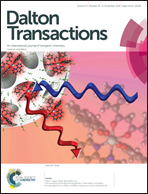Copper(i)-assisted red-shifted phosphorescence in Au(i)⋯Cu(i) heteropolynuclear complexes†
Abstract
Reactions between [Au(C6Cl2F3)(tht)] and P,N-donor bridging ligands of the type PPh2py and (PPh2)2phen lead to the homonuclear gold complexes [Au(C6Cl2F3)(PPh2py)] (1) and [Au2(C6Cl2F3)2{(PPh2)2phen}] (2). Subsequent addition of [Cu(CH3CN)4](BF4) leads to the formation of the corresponding gold–copper heterometallic complexes [Au2Cu(C6Cl2F3)2(PPh2py)2](BF4) (3) and [Au2Cu(C6Cl2F3)2{(PPh2)2phen)}(CH3CN)](BF4) (4). The four complexes have been structurally characterized and are luminescent. The gold precursors show emissions arising from metal-perturbed intraligand transitions. The heterometallic complexes show a red shift of the emissions that is proposed to arise from an admixture of IL (intraligand) and MLCT (metal-to-ligand-charge-transfer) transitions. DFT and TD-DFT calculations agree well with these results.


 Please wait while we load your content...
Please wait while we load your content...